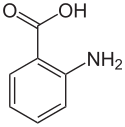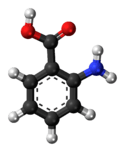Anthranilic acid
| |||
| Names | |||
|---|---|---|---|
| IUPAC name
2-Aminobenzoic acid | |||
| Other names
o-Aminobenzoic acid; 2-Aminobenzoic acid; Vitamin L1; Anthranilate | |||
| Identifiers | |||
3D model (JSmol) |
|||
| ChEBI | |||
| ChEMBL | |||
| ChemSpider | |||
| DrugBank | |||
| ECHA InfoCard | 100.003.898 | ||
| EC Number | 204-287-5 | ||
| KEGG | |||
PubChem CID |
|||
| RTECS number | CB2450000 | ||
| |||
| |||
| Properties | |||
| C7H7NO2 | |||
| Molar mass | 137.14 g·mol−1 | ||
| Appearance | white or yellow solid | ||
| Odor | odorless | ||
| Density | 1.412 g/cm3 | ||
| Melting point | 146 to 148 °C (295 to 298 °F; 419 to 421 K)[1] | ||
| Boiling point | 200 °C (392 °F; 473 K) (sublimes) | ||
| 0.572 g/100 mL (25 °C) | |||
| Solubility | very soluble in chloroform, pyridine soluble in ethanol, ether, ethyl ether slightly soluble in trifluoroacetic acid, benzene | ||
| log P | 1.21 | ||
| Vapor pressure | 0.1 Pa (52.6 °C) | ||
| Acidity (pKa) | 2.14 | ||
| -77.18·10−6 cm3/mol | |||
Refractive index (nD) |
1.578 (144 °C) | ||
| Thermochemistry | |||
Std enthalpy of formation (ΔfH |
-380.4 KJ/mol | ||
| Hazards | |||
| Safety data sheet | External MSDS | ||
| R-phrases (outdated) | R36 R37 | ||
| S-phrases (outdated) | S26 S39 | ||
| NFPA 704 | |||
| Flash point | > 150 °C (302 °F; 423 K) | ||
| > 530 °C (986 °F; 803 K) | |||
| Lethal dose or concentration (LD, LC): | |||
LD50 (median dose) |
1400 mg/kg (oral, rat) | ||
Except where otherwise noted, data are given for materials in their standard state (at 25 °C [77 °F], 100 kPa). | |||
| Infobox references | |||
Anthranilic acid (o-amino-benzoic acid, 2-aminobenzoic acid, 2-AA, 2AA, AA)[2][3] is an aromatic acid with the formula C6H4(NH2)(CO2H). The molecule consists of a substituted benzene ring, hence is classed as aromatic, with two adjacent, or "ortho-" functional groups, a carboxylic acid and an amine. The compound is consequently amphoteric. In appearance, anthranilic acid is a white solid when pure, although commercial samples may appear yellow. It is sometimes referred to as vitamin L1 and has a sweetish taste.[4] The anion [C6H4(NH2)(CO2)]−, obtained by the deprotonation of anthranilic acid, is called anthranilate.
Structure
Although not usually referred to as such, it is an amino acid. Solid anthranilic acid consists of both the amino-carboxylic acid and the zwitterionic ammonium carboxylate forms.[5]
Production
Many routes to anthranilic acid have been described. Industrially it is produced from phthalic anhydride, beginning with amination:
- C6H4(CO)2O + NH3 + NaOH → C6H4(C(O)NH2)CO2Na + H2O
The resulting sodium salt of phthalamic acid is decarbonylated via a Hofmann rearrangement of the amide group, induced by hypochlorite:[6]
- C6H4(C(O)NH2)CO2Na + HOCl → C6H4NH2CO2H + NaCl + CO2
A related method involves treating phthalimide with sodium hypobromite in aqueous sodium hydroxide, followed by neutralization.[7] In the era when indigo dye was obtained from plants, it was degraded to give anthranilic acid.
Anthranilic acid was first obtained by base-induced degradation of indigo.[8]
Biosynthesis
Anthranilic acid is biosynthesized from chorismic acid. It is the precursor to the amino acid tryptophan via the attachment of phosphoribosyl pyrophosphate to the amine group.
.svg.png)
Uses
Industrially, anthranilic acid is an intermediate in the production of azo dyes and saccharin. It and its esters are used in preparing perfumes to imitate jasmine and orange, pharmaceuticals (loop diuretics e.g. furosemide) and UV-absorber as well as corrosion inhibitors for metals and mold inhibitors in soy sauce.
Anthranilic acid can be used in organic synthesis to generate benzyne.[9] The benzyne rapidly dimerizes to form biphenylene. It reacts with phosgene to give isatoic anhydride, a versatile reagent.[10]
Chlorination of anthranilic acid gives the 2,4-dichloro derivative.[11]
Anthranilate-based insect repellents have been proposed as replacements for DEET.
Fenamic acid is a derivative of anthranilic acid,[12]:235 which in turn is a nitrogen isostere of salicylic acid, which is the active metabolite of aspirin.[12]:235 Several non-steroidal anti-inflammatory drugs, including mefenamic acid, tolfenamic acid, flufenamic acid, and meclofenamic acid are derived from fenamic acid or anthranilic acid and are called "anthranilic acid derivatives" or "fenamates".[13]:17
Safety and regulation
It is also a DEA List I Chemical because of its use in making the now-widely outlawed euphoric sedative drug methaqualone (Quaalude, Mandrax).[14]
See also
References
- ↑ IPCS
- ↑ Acton, Q. Ashton (2013). Aminobenzoic Acids—Advances in Research and Application (2013 ed.). Atlanta: ScholarlyEditions. p. 23. ISBN 9781481684842 – via Google Books.
- ↑ Hardy, Mark R. (1997). "Glycan Labeling with the Flurophores 2-Aminobenzamide and Antranilic Acid". In Townsend, R. Reid; Hotchkiss, Jr., Arland T. Techniques in Glycobiology. Marcel Dekker, Inc. p. 360. ISBN 9780824798222 – via Google Books.
- ↑ The Merck Index, 10th Ed. (1983), p.62., Rahway: Merck & Co.
- ↑ C. J. Brown "The Crystal Structure of Anthranilic Acid" Proc. Royal Society of London A, 1968, vol. 302, pp. 185-199. doi:10.1098/rspa.1968.0003
- ↑ Takao Maki, Kazuo Takeda "Benzoic Acid and Derivatives" in Ullmann's Encyclopedia of Industrial Chemistry 2002, Wiley-VCH, Weinheim. doi:10.1002/14356007.a03_555.
- ↑ Vogel's Textbook of Practical Organic Chemistry, 4th Ed., (B. S. Furniss et al., Eds.) (1978), p.666, London: Longman.
- ↑ Fred E. Sheibley "Carl Julius Fritzsche and the Discovery of Anthranilic Scid, 1841" J. Chem. Educ., 1943, volume 20, p 115. doi:10.1021/ed020p115
- ↑ Logullo, F. M.; Seitz, A. H.; Friedman, L. (1973). "Benzenediazonium-2-carboxy- and Biphenylene". Organic Syntheses. ; Collective Volume, 5, p. 54
- ↑ E. C. Wagner, Marion F. Fegley. (1947). "Isatoic anhydride". Org. Synth. 27: 45. doi:10.15227/orgsyn.027.0045.
- ↑ Edward R. Atkinson, Donald M. Murphy, James E. Lufkin "dl-4,4',6,6'-Tetrachlorodiphenic Acid" Org. Synth. 1951, volume 31, 96. doi:10.15227/orgsyn.031.0096.
- 1 2 Sriram D, Yogeeswari P. Medicinal Chemistry, 2nd Edition. Pearson Education India, 2010. ISBN 9788131731444
- ↑ Auburn University course material. Jack DeRuiter, Principles of Drug Action 2, Fall 2002 1: Non-Steroidal Antiinflammatory Drugs (NSAIDS)
- ↑ Angelos SA, Meyers JA (1985). "The isolation and identification of precursors and reaction products in the clandestine manufacture of methaqualone and mecloqualone". Journal of Forensic Sciences. 30 (4): 1022–1047. PMID 3840834.


